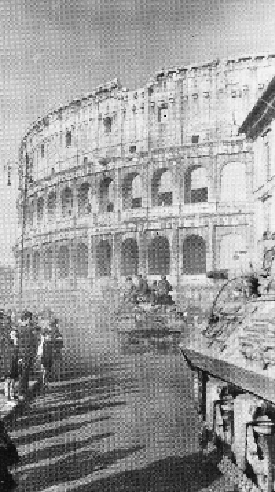Rome was the primary target for the Allies in Europe’s “soft underbelly” in 1944 once Monte Cassino had fallen and the forces at Anzio had moved out of their beachhead. As the capital of Italy, it was hoped that the capture of Rome would be sufficient for the Italians to sue for peace.
The resistance faced by the Allies at Monte Cassino and Anzio was severe. It was believed that the Allies drive to Rome was expected to face similar enemy resistance as Hitler had ordered his forces to ‘bleed the Allies white’.
Once Monte Cassino had fallen, the Allies faced another challenge as they moved north – the Adolf Hitler Line. This had been constructed from Terracina on the west coast of Italy to Monte Cairo, to the northwest of Monte Cassino. This armoured defensive line had concrete fortifications and nearly 200 ‘armoured crabs’ to defend it. However, the Canadians broke through the line on May 22ndand on the following day the British 8th Army launched a major attack that broke the line completely. A meeting with the forces that had broken out of the Anzio beachhead was just days away.

On May 25th 1944, the US 6th Corps, which had landed at Anzio, met up with the US 2ndCorps, which had fought at Monte Casino, just to the east of Latina by the Pontine Marshes. The French Expeditionary Corps, the Canadian 1st Corps, the British 13th Corps and the Polish 2nd Corps all advanced north through central Italy. However, all of these corps had the same target – Rome.
While forces in central Italy had to cross high ground as they advanced, those nearer the coast did not. Once the Allies had met near Latina, Rome was just forty miles to the north. Hitler had given Kesselring, the German c-in-c in Italy, permission to withdraw his men to the Caesar Line, some ten miles south of Rome. Here they were told to make a stand.
“It is the Fuhrer’s explicit order and also my belief that we must bleed the enemy to exhaustion by hard fighting.” (Kesselring)
The Allies faced an enemy that was willing to put up a fight and in areas along the front line the Allies faced a determined enemy. However, the constant onslaught of a much better equipped army bled the German defenders even more. While the Allies could supply their forces with a degree of ease as they had mastery of the air, the same was not true of the Germans. Their supply routes north of Rome had been bombed and many vital communication links had been destroyed. While the Allies suffered from the stubborn resistance they had to face, the defeat of the German forces was inevitable, especially after the Caesar Line fell on May 30th. On June 2nd 1944, Kesselring asked permission to withdraw from Rome. The agreement to do this came on June 3rd. In fact, Kesselring had pre-emptied this permission and troops were already being withdrawn from Rome.
On June 4th, as German troops were evacuating the city to the north, American troops entered Rome in the south. By midnight, US troops from the 5th Army had crossed the River Tiber. By the end of June 6th, the Allies were pursuing the Germans north of Rome in a conflict that would take another two months before the Allies reached the Arno River at the end of July.
The Spring Offensive against the Germans – the push out of Anzio and the capture of Monte Cassino – had cost the Americans about 30,000 men, the British about 12,000 men and the Germans about 25,000 men. Rome was the first Axis capital to fall in the war. On June 9th Ivanoe Bonomi, a prominent anti-Fascist politician, formed a new government. Allied troops were invariably welcomed in any Italian town they relieved. However, perhaps the greatest contribution made by this campaign was the fact that in the summer of 1944, many thousands of experienced German troops had been tied up in Italy and as such could not be transferred to the new front that had been opened in France as a result of D-Day.